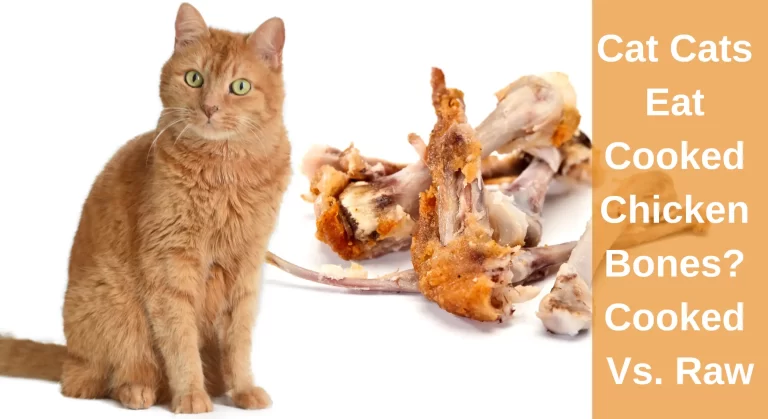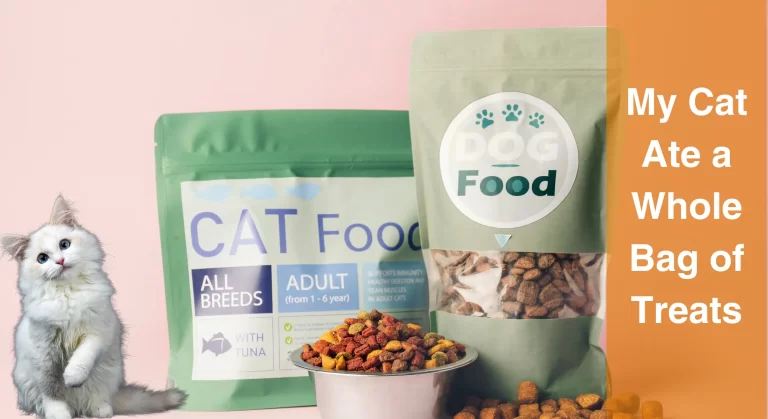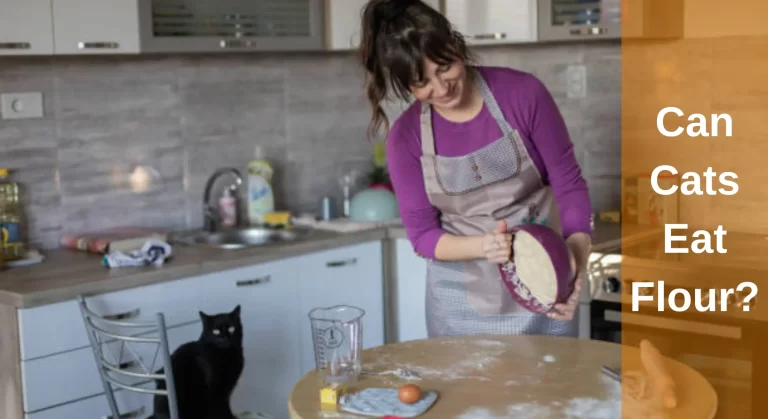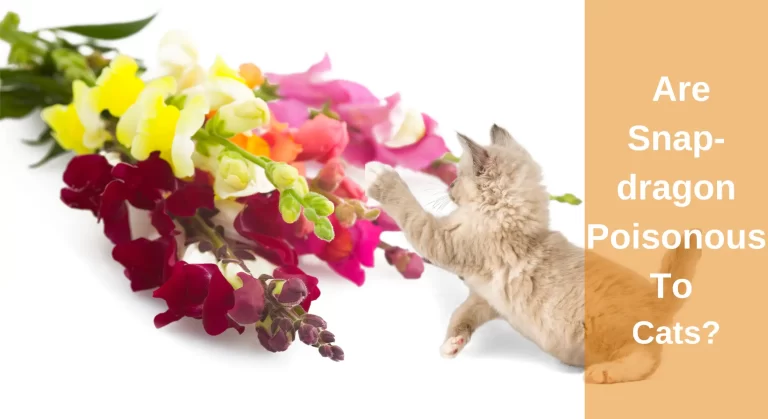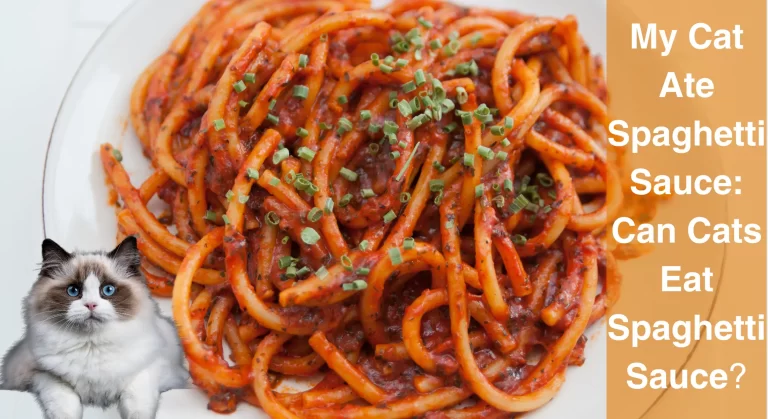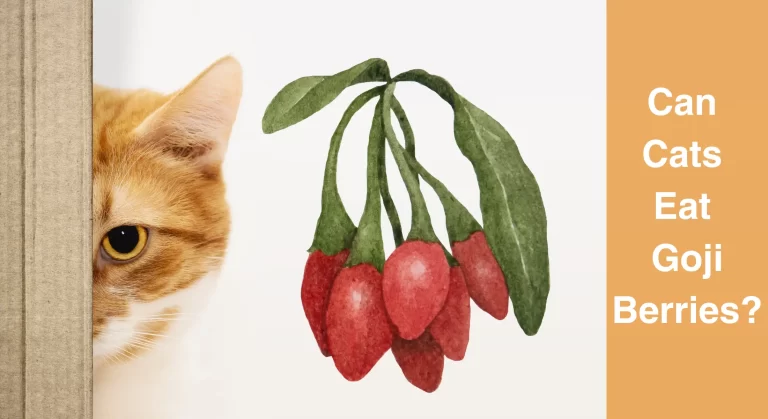Is It OK if My Cat Only Eats Dry Food? Pros And Cons of Kibble
With so many cat food options in your local supermarket, it can be overwhelming when deciding which one to pick up. How do you know which product is best for your cat? It seems straightforward to pick up a random packet and serve it to your cat. Still, every cat owner is rightfully concerned for their cat’s health, and food is one of the most significant contributors to health.
Is It OK if My Cat Only Eats Dry Food? You can definitely feed your pet only kibble as long as the food meets their nutritional needs and they are drinking enough water. There is nothing wrong with it as long as you have a healthy adult cat with no dental issues and as long as it is high-quality kibble. Lower-quality cat food uses carbohydrates as fillers, which is not ideal for your feline. However, incorporating wet food into their diet can provide additional hydration and nutrients.
Continue reading to learn more about – You can divide cat food into wet and dry cat food. But which one is best? Is grabbing a big bag of kibble enough for your feline? Or should you mix it up?
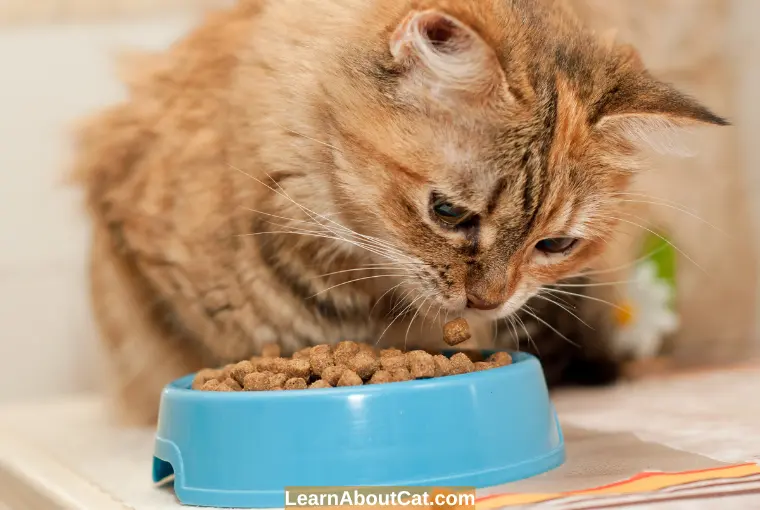
Can Cats Live on Dry Food Only?
While cats can technically survive on a diet of dry food alone, it is not recommended. Cats have specific nutritional requirements that must be met to maintain optimal health. A diet that consists solely of dry food may not provide all of the essential nutrients that your cat needs.
Many cat owners prefer to feed only dry kibble due to its longer shelf life and fewer chances of going bad if your cat leaves leftovers in their bowl. Is it, by the way, named “cat food” for a reason, as it meets all your pet’s nutritional and caloric requirements?
If you decide to keep your pet on a kibble diet, there are a few things you should be aware of.
Firstly, make sure they drink water. Kibble only has around 7-12% moisture content, and cats are not good at hydrating themselves. If you have a cat that does not drink water, you need to incorporate canned food into its diet to maintain its hydration levels.
Secondly, make sure to purchase high-quality dry food. Fillers made of carbohydrates are found in lower-quality dry food. These are more difficult for your cat’s gut to break down. In particularly sensitive felines, this can cause vomiting and diarrhoea.
While shopping for kibble:
- Look for low carbohydrates.
- High fibre.
- Natural animal protein.
- Contains Vitamins and minerals.
- And Fatty acids to boost the immune system.
Intresting Reading: A Guide To How To Soften Dry Cat Food?
Advantages of Feeding Dry Food
There are several advantages to feeding dry food to cats, including:
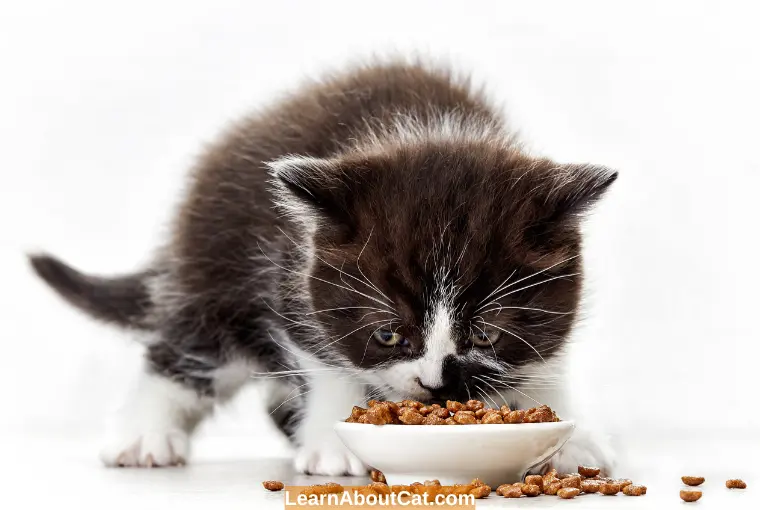
1. Convenient and Economical
One of the primary advantages of feeding dry food to your cat is convenience. For cat owners who may not have the time or resources to prepare fresh meals for their cats every day.
It is easy to store and can be purchased in large quantities, which can save time and money in the long run.
Dry food is readily available in pet stores and grocery stores, making it easy to purchase and store.
Additionally, dry food tends to be more economical than wet food, which can be an important consideration for cat owners on a tight budget.
2. Promotes Dental Health
One of the biggest benefits of dry food for cats is that it can help promote good oral hygiene. Dry food can be beneficial for your cat’s dental health.
The crunchy texture of dry kibble helps to scrape away plaque and tartar, reducing the risk of dental problems such as gum disease and tooth decay.
3. Long Shelf Life
Another advantage of dry food is its long shelf life. Unlike wet food, which needs to be refrigerated and consumed within a few days, dry food can be stored in a cool, dry place for an extended period without spoiling.
4. Reduces Risk of Bacterial Infections
Feeding your cat dry food can reduce the risk of bacterial infections. Wet food, especially if left out for an extended period, can become a breeding ground for harmful bacteria such as Salmonella and E. coli, which can cause illness in both cats and humans.
What Are the Risks of a Dry Food Diet?
Although dry cat food is not inherently dangerous, there are a few things you should consider:
1. Risks of Dehydration
One of the major drawbacks of feeding dry food to your cat is that it can lead to dehydration. Dry cat food does not contain enough water content to hydrate your feline, and as cats are poor drinkers, this may pose a problem. If your cat is dehydrated, it will get lethargic, weak, and will refuse to eat.
You can add canned food to their diet or purchase a water fountain specifically for cats. The flowing water is more appealing to your feline.
flowing water is safer than stagnant water in the wild, so the water fountain will get your cat into slurping water again.
2. Hish Risk of Obesity
Kibble is not the culprit here. The problem is “free-feeding”. Because kibble is dry food that can be left out without worrying about the fact that it may spoil, pet owners who work may leave out a lot of cat food for the entire day.
Hence, their cat has a constant supply of food. Unfortunately, your furry friend will overeat, leading to obesity.
Obesity in cats can lead to diabetes, heart problems, arthritis, and even tumours, so free feeding is never recommended in healthy adult cats.
Instead, you can get an automatic feeder. A lot of feeders cater to dry kibble. You can set the time and amount on it and go about your day worry-free.
3. Lack of moisture – Urinary Tract Diseases
This goes hand-in-hand with dehydration. The less water content your cat has, the more bacteria in the urinary tract get to thrive.
Cats are obligate carnivores, which means that their bodies are designed to obtain most of their water intake from their food.
Dry food contains very little moisture, which can put a strain on your cat’s kidneys and urinary tract. This can increase the risk of urinary tract infections and other health problems.
Your cat might make painful sounds while peeing, go to pee plenty of times and pass very little urine, or over-clean their genitals in an attempt to ease the discomfort.
Also, dry kibble contains minerals like calcium, magnesium, and phosphorus (known as “ash” on cat food packaging). Without water, these minerals can condense into your pet’s urinary system, causing urolithiasis or kidney stones, which are very painful.
If your cat gets urine infections often, it’s recommended to switch to canned food or go for dry kibble with low “ash” content.
4. High in carbohydrates
Many types of dry cat food are high in carbohydrates, which can be harmful to your cat’s health if consumed in excess. Carbohydrates can contribute to weight gain, diabetes, and other health problems in cats.
5. Preservatives and Additives
Many dry cat foods contain preservatives and additives, which can be harmful to your cat’s health. Ingredients such as artificial colours, flavours, and preservatives have been linked to a range of health problems, including allergies, hyperactivity, and cancer.
Find Out: My Cat Ate a Whole Bag of Treats: What Should I Do?
What are the Situations in Which Dry Food Shouldn’t be Fed to a Cat?
Even though dry cat food is widely marketed as the go-to cat diet (and it can be for healthy adult cats), there are some circumstances where the dry cat food is not recommended for your pet:

1. Dry Food should not be given to Kittens
Kittens are initially on their mother’s milk and start weaning at the age of four weeks. From week four to week six, they need soft foods to start off with, as they are in the first stage of teething and have deciduous teeth.
These teeth are not strong enough to properly chew and break down dry kibble, so there is a choking hazard when it comes to giving kittens kibble.
You can give your pet kitten kibble at six weeks, but that two after pouring a tablespoon or two of water over it, so it softens and is easier to chew.
2. Cats with Recurring Urinary Issues
As discussed, dry kibble contains “ash”, which can mineralize in the urinary tract causing kidney stones. If your cat has a history of UTIs, it is best to switch to canned food and take a trip to the vet.
3. Cats with Gastrointestinal problems
Some felines cannot tolerate dry kibble and develop symptoms like vomiting and diarrhoea. It is recommended to get higher quality kibble as they do not contain carbohydrate “fillers”.
If that does not solve the problem, you should opt for wet canned food as it is easier to digest because its consistency is close to their natural prey in the wild.
4. Cats with Teeth Problems
Cats with periodontitis, odontitis, or tooth resorption will have a harder time chewing on hard, dry kibble. The inflammation going on in their mouths makes eating kibble a painful experience. This may prevent them from eating altogether.
If you notice your cat has suddenly stopped eating dry kibble but eats wet canned food or treats, pawing at its mouth or drooling and swelling of the gums, it is a good idea to schedule a visit to the vet.
How to Ensure Your Cat is Receiving a Balanced Diet
If you choose to feed your cat a dry food-only diet, it is important to select a high-quality brand that is formulated to meet your cat’s nutritional needs. Here are some things to consider:
- Quality of Ingredients: Look for dry food that is made from high-quality ingredients, such as real meat and vegetables. Avoid foods that contain fillers, by-products, and artificial preservatives.
- Protein Content: Cats require a diet that is high in protein to maintain optimal health. It is recommended to choose dry food with a high protein content and low carbohydrates.
- Avoiding fillers and by-Products: Avoid dry food that contains fillers and by-products, since they can be detrimental to your cat’s well-being. Search for food that discloses real meat as the primary ingredient and does not consist of fillers like wheat, corn, or soy.
- Homemade Meals: You can also supplement your cat’s diet with wet food or homemade meals to ensure that they are receiving a well-balanced diet. Wet food can provide additional moisture and protein, while homemade meals can be tailored to your cat’s specific nutritional needs.
- Offer Fresh Water: As dry food can cause dehydration, it’s imperative to provide your cat with fresh water consistently. You can consider acquiring a water fountain or similar device to encourage your cat to drink more water.
- Consulting with a Veterinarian: If you are uncertain about the appropriate dry food for your cat, it is advisable to consult a veterinarian. They can propose a diet that caters to your cat’s specific health requirements.
Common Myths About Cat Nutrition
There are several common myths about cat nutrition that can be misleading. For example, some people believe that cats should only eat raw meat or that grains are harmful to cats. However, these beliefs are not based on scientific evidence and can actually be harmful to your cat’s health.
Frequently Asked Questions
Can a cat live a healthy life on dry food only?
Of course! Dry cat food is specifically designed for cats, so an adult cat can only live a long and healthy life on kibble. You just need to make sure your cat stays hydrated.
Is it okay if my cat only eats wet food?
Veterinarians recommend that cats exclusively eat canned food due to its high moisture content and dry kibble-containing carbohydrates. Cats are obligate carnivores, so they need a diet rich in protein. Canned food meets this requirement better than kibble.
How much dry food should I feed my cat?
The amount of dry food you should feed your cat depends on its age, weight, and activity level. As a general rule, adult cats should eat about 3-4 small meals of dry food per day, with each meal consisting of about 1/4 to 1/3 cups of food. However, it’s always best to consult with your veterinarian to determine the appropriate feeding amount for your specific cat.
Is it better to feed my cat wet food or dry food?
Both wet and dry food can be a part of a balanced diet for cats. It is important to choose high-quality food that meets your cat’s specific nutritional needs.
Closing Words!
Kibble or dry cat food is a popular diet choice for many cat owners. Felines seem to enjoy it and technically possible for cats to survive on a diet of dry food alone, but it should not be the sole source of nutrition. Dry food can be harmful to your cat’s health if consumed in excess and didn’t drink enough water or if it does not provide all of the essential nutrients that your cat needs.
It is important to choose the right type of dry food and to balance it with wet food to ensure that your cat is getting all of the nutrients that they need.
However, it is best to switch to canned food if you have a kitten from 4-6 weeks of age or a cat with urinary, dental, or hydration problems. Remember to consult with your veterinarian if you are unsure about what type of food to feed your cat.
Related Posts:
- Cat Not Eating or Drinking- How Long Can a Cat
- Can Cats Drink Spring Water? (Spring Water vs. Tap Water)
- Older Cat Not Eating But Drinking: Reasons And How to Help
- Why Is My Cat Always Hungry But Skinny?
- Do Kittens Need Wet Food?
- Why is There Ash in Cat Food?
- Pros and Cons of Grain-Free Diet for Cat
- How Long Does Canned Cat Food Last?
- Do Cat Treats Expire? Are Expired Cat Treats Safe
- Can I Leave Wet Cat Food Out Overnight?
- What To Do With Leftover Cat Food?
Who is Isabella?
My name is Isabella, and I am a dedicated and knowledgeable cat enthusiast. With years of experience caring for cats and a deep love for felines, I made a mission to help other cat lovers navigate the challenges of cat ownership.

